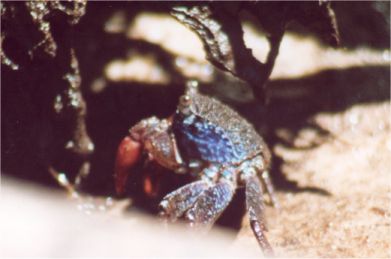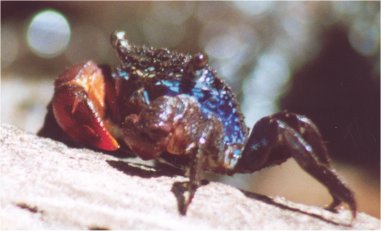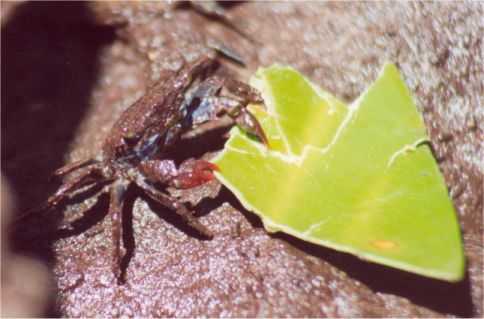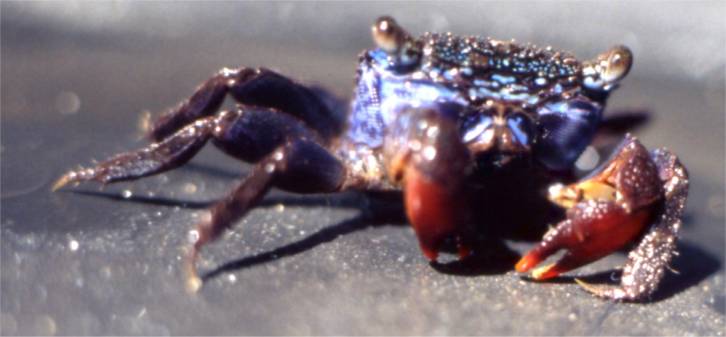|
A field guide to Kenyan
mangroves
|
Perisesarma samawati Gillikin & Schubart, 2004
Family: Sesarmidae

Zone: Can be found primarily in Rhizophora mucronata zone, restricted to muddier regions (Gillikin & Schubart, 2004).
Habitat: On the forest floor, uses natural crevices and apparanly is faithful to the crevicves; it is not clear if they maintain the crevices they inhabit (Gillikin & Schubart, 2004).
|
Food: Probably omnivorous, will readily consume green mangrove leaves (see image at bottom of page). Often, P. samawati were observed picking minuscule items off the sediment surface and bringing it to their mouth-parts (Gillikin & Schubart, 2004), so probably are also sediment feeders, like many mangrove crabs (Bouillon et al., 2002; 2004). Ecological notes: Very common in riverine mangrove forest, but avoids drier areas, occurs in high densities (although seemingly less than P. guttatum) (Gillikin & Schubart, 2004). Probably very important in leaf litter removal. Much more shy than P. guttatum (Gillikin & Schubart, 2004). Maturity in males reached at about the same carapace width as P. guttatum (Gillikin & Schubart, 2004). |
|
| Distinguishing characteristics: This new species is similar
in size and appearance to P. guttatum
(with which it has been confused with up until recently). P. samawati has 7-8 tuberlces
on the top of the claw (see images to the left), while
P. guttatum has
11-13 tuberlces. P. guttatum is usually dark brown in Kenya, while P. samawati
is different shades of blue (see image below). This is the 23rd Perisesarma
species to be described worldwide and the 20th in the Indo-Pacific region
(See list of all Perisesarma described to date).
|
Geographical range: Kenya and probably most of East Africa.




References:
Bouillon, S., Koedam, N., Raman, A.V., Dehairs, F., 2002. Primary producers sustaining macro-invertebrate communities in intertidal mangrove forests. Oecologia 130: 441-448 (reprint available here).
Bouillon S, Moens T, Overmeer I, Koedam N, & Dehairs F (2004) Resource utilization patterns of epifauna from mangrove forests with contrasting inputs of local versus imported organic matter. Marine Ecology Progress Series 267: 57-69.(reprint available here).
Gillikin, D.P. and C.D. Schubart, 2004. Ecology and systematics of mangrove crabs of the genus Perisesarma (Crustacea: Brachyura: Sesarmidae) from East Africa. Zoological Journal of the Linnean Society 141 (3): 435-445. (REPRINT).